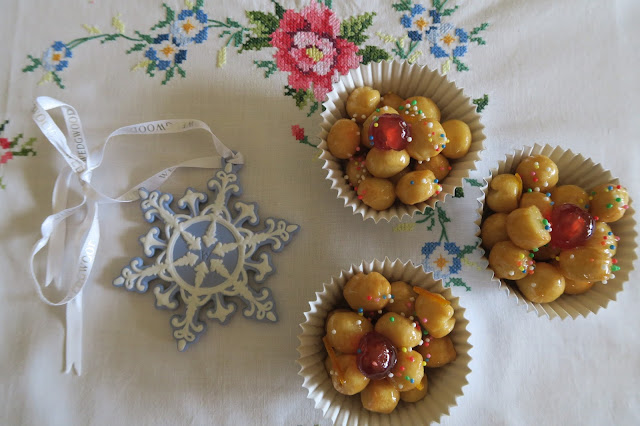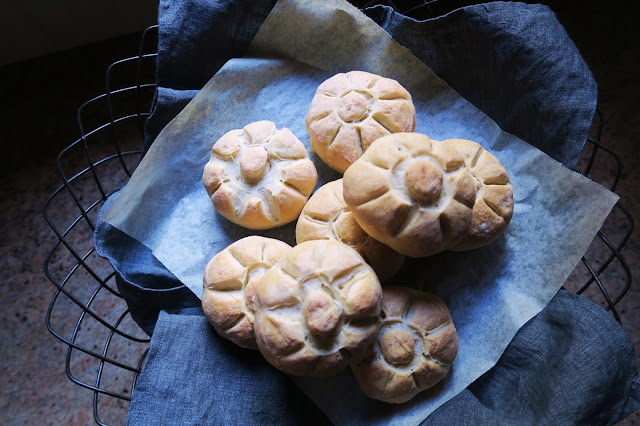This line in part borrowed from William Shakespeare’s
famous written words is, in fact, quite appropriate. But am I being too philosophical in my
introduction to this sweet that is known by many other names depending
on which region of Italy you are from? Perhaps, but a sweet that by any name and in whichever region, is loved for what it is; a simple sweet that is made for the
Christmas table to be shared.
This month’s Cucina Conversations posts will be dedicated to the festive season – recipes ideal for gift
giving or to share as part of your Christmas feast. Francesca will be making canederli, a regional dish inspired by her recent trip to the north of Italy, Bolzano; Rosemarie will make her delicious croccante known to be a jaw breaker but very addictive. Two of my favourite biscuits are being baked - Daniela is making Siena's almond ricciarelli which date bake to the 14th century, and Lisa is making a specialty from Turin known as baci di dama. Flavia is busily preparing Italian waffles called pizzelle before she flies off to Italy,
while Marialuisa will make her traditional ciciarata,
whose name should not to be confused with la
cicerata that I have prepared for you.
Festivities are a time when many Italians gather around a table showcasing their regional delicacies. In my family we are fortunate to have dishes
representing the regions of both Basilicata and Sicilia as part of our
shared Christmas table. Every year my
mother or I make la cicerata, a sweet
originating from the south of Italy that is prepared together and shared on
this special day. Although considered a ‘poor’
desert, it is rich in childhood memories of us working together to create a lovely wreath using simple ingredients. It is also a sweet that has some history connected to its original name. The Neapolitan's adopted this sweet from the Grecian's
when it was exported to the Golf of
Naples and named it struffoli, derived from the Greek word strongoulos meaning rounded. It is also written that Nuns of various
orders would prepare this sweet in the convent around Christmas
time and gift it to noble families who had demonstrated acts of charity
throughout the year in Naples.
Although a sweet whose adopted origins is the south of Italy,
it is one that is well known throughout Italy; whose ingredients and
preparations are similar, but each region has given it a different name. In Palermo one of the ‘f’ is
dropped off and written as strufoli. In Abbruzzo, Molise and le Marche, it
is referred to as cicerchiata, in Puglia it is known as purciadduzzi and in
Calabria – turdiddi or pignolata. My mother in law used to make a version of this sweet and called it mpagnuccata and added sugar to the honey glaze.
Both
my parents are from the Basilicata region and call this sweet la cicerata, which comes from the dialect word ciceri as they resemble chickpeas. The sweets from this region were generally
very simple but significant and considered a luxury. They did not form part of the daily meal and
appeared on the table mainly on festive occasions, and this is why my parents
recall this sweet with fond memories. These small puff balls of fried dough are assembled
with a honey glaze in the form of a wreath. In more lavish times, it has been decorated
with chopped almonds, glace` cherries and candied fruits. Some regions however,
still maintain its simplistic original preparation and presentation using only honey
and grated citrus.
La cicerata is a favourite from my mother’s town - Montemurro. My grandmother along with her daughters would sit around the kitchen table and
work together in creating this desert for Christmas day. It is a lovely dish to prepare with your loved
ones and with a little creativity it can produce an inspiring wreath for the
Christmas table, or simply assembled in cupcake cases if individual small
portions are preferred.
La Cicerata
Ingredients:
Pastry
500 g plain flour
2 teaspoons baking powder
3 eggs
50 g castor sugar
brandy (or favourite liqueur)
zest of 1 orange
vegetable oil for frying
Glaze:
375 g honey
2 tbsp finely sliced orange rind (pith
removed)
Decorations of choice - chopped almonds, glace` cherries, sprinkles (optional)
Combine the flour, baking powder, zest of orange, sugar,
eggs with sufficient liqueur to form a firm dough. Knead lightly, wrap in cling
wrap and allow resting for 1 hour.
Divide the dough and roll into long thin sticks of
approximately 1 cm thickness, then cut into pieces and roll into small
balls. The process is time consuming, but
with many hands on board it can be done in half the time.
Heat the vegetable oil in a pan and fry the small balls in
batches until golden brown. Drain on kitchen paper. Repeat the process until
all pastry has been fried.
Heat
the honey in a saucepan and allow boiling for 3-4 minutes. Add the thin slices of orange rind, chopped almonds, pastry balls and toss to coat well. Remove the honey coated pastries with a
slotted spoon and transfer onto a serving dish forming the shape of a wreath. Decorate to your liking. My mother would
decorate her wreath with green and red glace` cherries, adding chopped almonds
and sprinkles. I have in the past decorated my wreath with spun sugar
and fresh flowers, or added Christmas decorations around it.
The fried balls can also be prepared
in advance and kept in a sealed container until ready to be served, in which
time it is cooked in honey and decorated.

This sweet is very popular with the children and I hope you enjoy making it for your Christmas table. Remember to also read the Cucina Conversations posts leading up to Christmas which I will link you to as soon as they are published.
Rosemarie at Turin Mamma
Daniela at La Dani Gourmet
Lisa at Italian Kiwi
Marialuisa at Marmellata di Cipolle
Flavia at Flavias Flavors
Francesca at Pancakes and Biscotti
As I will be hosting Christmas lunch this year, this will be my last post before the big day but will still be active on social media and back in the new year with more recipes in addition to my Cucina Conversations monthy posts. I hope you have enjoyed our posts thus far and 2017 promises to bring many more delicious recipes from this group. I am so grateful for the connections and friendships made and thank you for all the lovely comments. I wish you a safe, happy Christmas and a wonderful break
with your loved ones.
Buon Natale a tutti!







Lovely description Carmen, Thanks for the history, so interesting. We had a very different Pastry in our Pignolata, And you're right Children love both: making and eating it.
ReplyDeleteThank you Marialuisa. It was interesting to read about its history and origins, especially coming from Greece. I have a few Greek friends and will ask them if they make this sweet as well. Your recipe is the first one I have come across that is so different. Will have to try it too.
ReplyDeleteWow, it's so great to have clarification with the names! Thanks for providing an exhaustive list of these. I've always known cicerata as pignolata but yes, over the years I've lived in Italy, I've noticed that the name differs from region to region. Also, very interesting to find out the Greek origins of this preparation. Definitely one I'd like to try making Christmas!
ReplyDeleteThank you Rosemarie, the funny thing is that I am coming across more names for this sweet. It is endless. They are predominantly dialect derived. How interesting is that! You will enjoy making it with your little one.
ReplyDeleteWhat an amazing looking cake! I've never seen anything like it. It must gets lots of "oohs and aahs" when it's served up!
ReplyDeleteThank you Lisa. It is quite special especially for the little ones.
DeleteOh, now you made me miss my Nonna! She'd prepare Cicerata every Christmas...
ReplyDelete